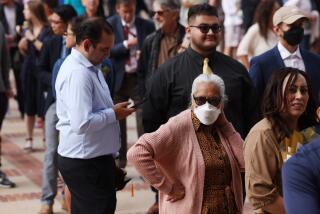STD rates jump in California in 2013, though chlamydia cases decline
The numbers of newly reported gonorrhea and syphilis cases jumped again in California in 2013, although the chlamydia rate edged down for the first time in almost two decades, the state Department of Public Health said this week.
Last year, rates of newly reported gonorrhea cases rose nearly 13%, and primary and secondary syphilis — the most infectious stages of the disease — jumped nearly 18% compared with 2012 levels, according to data released by the department Tuesday. Other types of syphilis also rose.
“This increase is concerning, particularly because STDs are preventable,” Dr. Ron Chapman, director of the department, said in a statement.
The chlamydia rate, meanwhile, sank almost 2% compared with 2012.
Chlamydia is by far the most common of the three sexually transmitted diseases, with 167,916 newly reported cases — or about 440 per 100,000 people — statewide last year. Nearly one-third of those cases were in Los Angeles County, whose rates were slightly higher than those of the state overall.
By contrast, there were 38,365 cases of gonorrhea (about 100 per 100,000 people), 3,554 cases of primary and secondary syphilis, and 6,558 cases of other newly reported syphilis statewide.
The diseases disproportionately affected African Americans, the figures showed: Blacks’ gonorrhea rates were more than three times the statewide average and six times as high as whites’, and their chlamydia rates were nearly twice the statewide average and more than five times as high as whites’.
Age was also a factor. People 15 through 24, especially women and girls, had the highest rates. More than 66% of female chlamydia cases and 54% of female gonorrhea cases statewide were in this age group, the Public Health Department noted, adding, “Young women are the most vulnerable to infertility and other long-term reproductive health problems caused by STDs.”
In 2011, rising rates of gonorrhea and chlamydia among young black women in South L.A. led county leaders and public health officials to team up with churches for an education and testing campaign.
Gonorrhea, syphilis and chlamydia can be cured with medication, but they can have irreversible effects if left untreated, according to the federal Centers for Disease Control and Prevention.
Chapman noted that people can reduce their risk by being tested regularly, using condoms and having fewer sexual partners.
For more news, follow @raablauren on Twitter.
More to Read
Sign up for Essential California
The most important California stories and recommendations in your inbox every morning.
You may occasionally receive promotional content from the Los Angeles Times.











